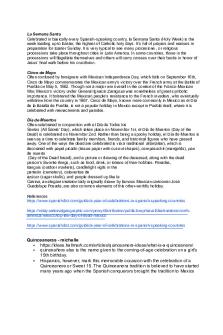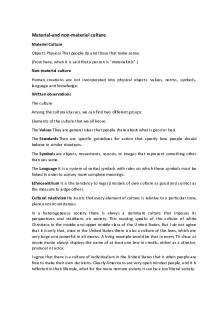Material Culture in the 1950s PDF

| Title | Material Culture in the 1950s |
|---|---|
| Author | Venus Heidari |
| Course | United States, 1865 To The Present |
| Institution | University of Oklahoma |
| Pages | 1 |
| File Size | 45.8 KB |
| File Type | |
| Total Downloads | 26 |
| Total Views | 143 |
Summary
Metcalf's Lecture Notes...
Description
Material Culture in the 1950s
- Post-War Economic Expansion • GNP nearly doubles from 1945 to 1960 • perpetual growth was thought to be likely and depressions impossible - Reasons for Growth • American economy expanded to fill the vacuum created by war-devastated economies in
-
-
-
-
-
Europe and Asia military spending continued innovations from military spending continued pent-up consumer demands from wartime “baby boom” “Boomers” Appear • filed by 16 million returning G.I.s • Baby Boom generation is those born between 1945 and 1964 - 78 million Americans Generation X (1965-1977) is only 45 million • • large families —> social obligation Consumer Culture • economists knew that to fuel continued economic expansion, Americans had to be taught to spend more and expect more - advertising - planned obsolescence Home Ownership • home ownership and material possession became normative World of Suburbia • suburbs grew six times faster than urban centers in 1950s Distorted Image • bombs, Red Scare, Cold War, Sputnik, etc. • people were terrified The Lonely Crowd • book by David Riesman • documented a fundamental shift from earlier “inner-directed” Americans to “other-directed” • Americans no longer did things based on their own internal compass • new Americans take values by the way people are around them Neo-orthodoxy • increased church attendance and religious revival • religion no longer stressed salvation and sin • designed to sell love, joy, and happiness Culture of Materialism • increasing number of young people began to feel that something was wrong with society • vast majority, though, never questioned the underlying premises of the progressive ideal (“American Dream”)
• • • •...
Similar Free PDFs

Material Culture in the 1950s
- 1 Pages

Culture and food in the UAE
- 11 Pages

Holidays in hispanic culture
- 5 Pages

Rape Culture in America
- 7 Pages

The location of culture
- 13 Pages
Popular Institutions
- Tinajero National High School - Annex
- Politeknik Caltex Riau
- Yokohama City University
- SGT University
- University of Al-Qadisiyah
- Divine Word College of Vigan
- Techniek College Rotterdam
- Universidade de Santiago
- Universiti Teknologi MARA Cawangan Johor Kampus Pasir Gudang
- Poltekkes Kemenkes Yogyakarta
- Baguio City National High School
- Colegio san marcos
- preparatoria uno
- Centro de Bachillerato Tecnológico Industrial y de Servicios No. 107
- Dalian Maritime University
- Quang Trung Secondary School
- Colegio Tecnológico en Informática
- Corporación Regional de Educación Superior
- Grupo CEDVA
- Dar Al Uloom University
- Centro de Estudios Preuniversitarios de la Universidad Nacional de Ingeniería
- 上智大学
- Aakash International School, Nuna Majara
- San Felipe Neri Catholic School
- Kang Chiao International School - New Taipei City
- Misamis Occidental National High School
- Institución Educativa Escuela Normal Juan Ladrilleros
- Kolehiyo ng Pantukan
- Batanes State College
- Instituto Continental
- Sekolah Menengah Kejuruan Kesehatan Kaltara (Tarakan)
- Colegio de La Inmaculada Concepcion - Cebu










